What You Missed at MozCon 2019 | Day 3
The three days spent in Seattle at MozCon 2019 were a great experience that I would recommend to any digital marketer or SEO specialist. As someone who works as the latter, the insights gained and actionable items were too many to count. We here at Boostability are dedicated to bringing you the best SEO focused content so you can help further your career or business—here are our takeaways from the final day of MozCon 2019.
Fraggles, Mobile-First Indexing, & the SERP of the Future | Cindy Krum
To see Cindy’s slide deck, click here. To see her blog post on Fraggles, click here.
Starting off day three, Cindy gave us some great insights on how Google is changing how they index pages and gather information for snippets. “Fraggles” are fragments + handles. A fragment is a piece of information on a webpage. A handle is something like a bookmark, jump link, or named anchor—they help people navigate through long pages to get what they’re looking for faster. Even though “Content is King,” the reality is that Mobile-First Indexing enables a new kind of search result landscape.
We are seeing the rise of new, innovative SERPS with the following:
Featured Snippets
PAA(People Also Ask)
PASF(People Also Search For)"Google is servicing answers more than websites."@Suzzicks #MozCon #BoostatMozCon
— Boostability (@Boostability) July 17, 2019
The problem that appears due to these new SERPs is that they are less and less trackable as the tools don’t yet exist to pull the data effectively. With Google stating that they moved to a mobile-first indexation, we know that they are prioritizing mobile content but what does that mean for you as a business?
It means you should have your website setup in a manner that Google can easily disseminate the information and value that you provide. You can do this by hiring someone who knows how to build websites that take this indexation into account. Business should also submit accurate information directly to Google whenever they can. They can do this through Google My Business and utilizing all the tools that Google offers them.
Think of answering questions rather than creating pages just for word count. Pages are an inefficient way to organize answers, so Google is indexing differently. Consider questions that your consumers would ask and answer them.
Crawling is inefficient. As the internet gets bigger, crawling in the hopes of finding something new doesn't scale. @Suzzicks #MozCon
— Ruth Burr Reedy (@ruthburr) July 17, 2019
Google wants to index more than just websites, but because the internet is getting bigger and bigger, traditional crawling is inefficient. That’s why being aware of the Google Knowledge Graph and how it operates can give you a leg-up for the future.
Killer Ecommerce CRO and UX Wins Using A SEO Crawler | Luke Carthy
To see Luke’s slide deck, click here. To see his blog post on eCommerce, click here.
Not providing a seamless experience for non-commerce search queries is leaving money on the table if you are an e-commerce centered business. You need to have your internal search do more for your customers and using SEO insights to optimize can help. Luke shows us how we can connect Conversion Rate Optimization(CRO) and SEO with custom extractions. Using Screaming Frog’s custom extraction allows you to scrape any data from the HTML of web pages when crawling and make decisions off that data.
The awesome @MrLukeCarthy on how to use custom extraction to extrapolate page elements such as whenever a “product not found” message is displayed on pages that may serve a 200 response code 👍🏽 #mozcon pic.twitter.com/Q1SAsJejXx
— Lily Ray 😏 (@lilyraynyc) July 17, 2019
You can also use custom extraction to see recommendations that your website is offering and optimize what your customers see when they are on the purchasing path. If products are out of stock then don’t just send the customer an ‘Out of Stock’ page. Send them a recommendation for something complimentary and similar.
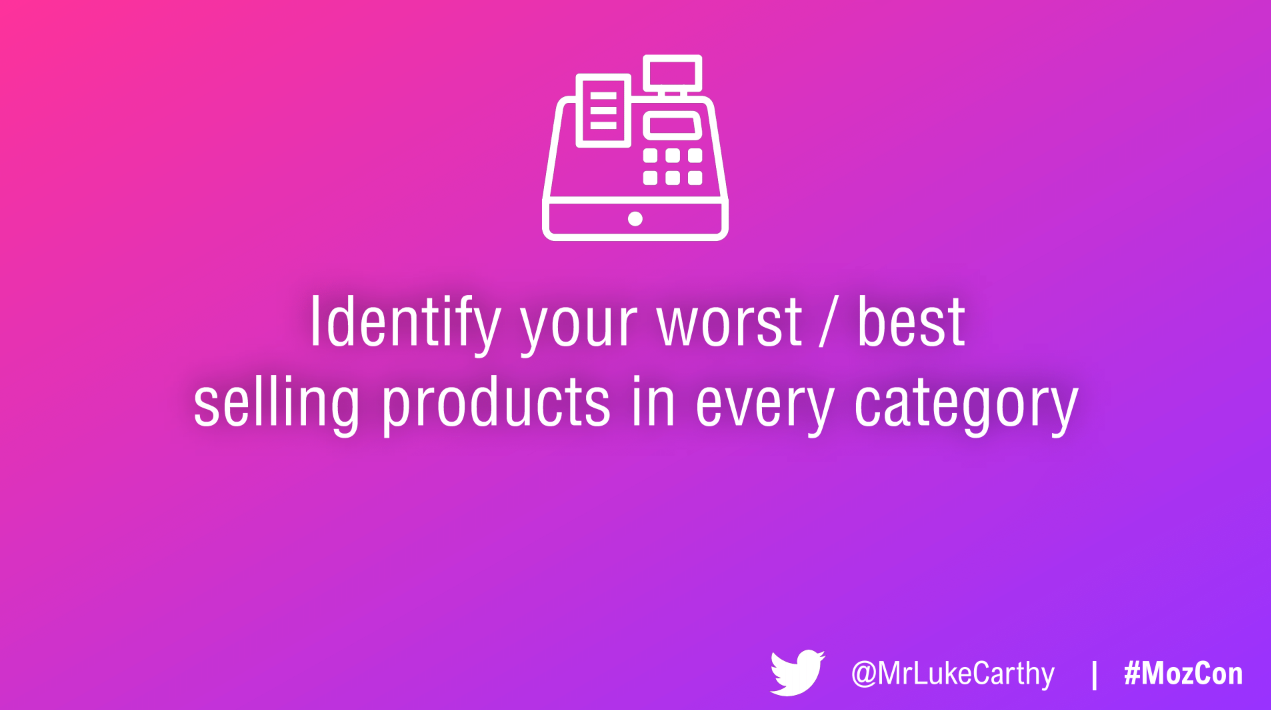
Best selling products are often the first items in their category. They can be the starting point of testing your onsite CRO. Identify your competition’s best (and worst) selling products and using a custom extraction from their site scrape results for price, reviews and stock to compare to your own.
Content, Rankings, and Lead Generation: A Breakdown of the 1% Content Strategy | Andy Crestodina
To see Andy’s slide deck, click here.
Andy walks us through how we can use our blog and content to help generate leads. When giving us an example of his own site findings he states, “Visitors who start their visit on a service page [rather than a blog page] are 50x more likely to become a lead.” Because your blog traffic typically doesn’t have commercial intent, it can be very difficult to get them to convert without a strategy. The obligation is then on the content creators and department to create a model that looks like this:
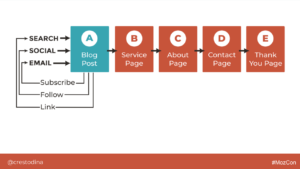
Ideally a good number of visitors to your blog would follow a funnel that you have setup and convert but in most instances that is not the case. What experienced SEOs do is leverage the equity made from quality posts and transfer it to your product and service pages.
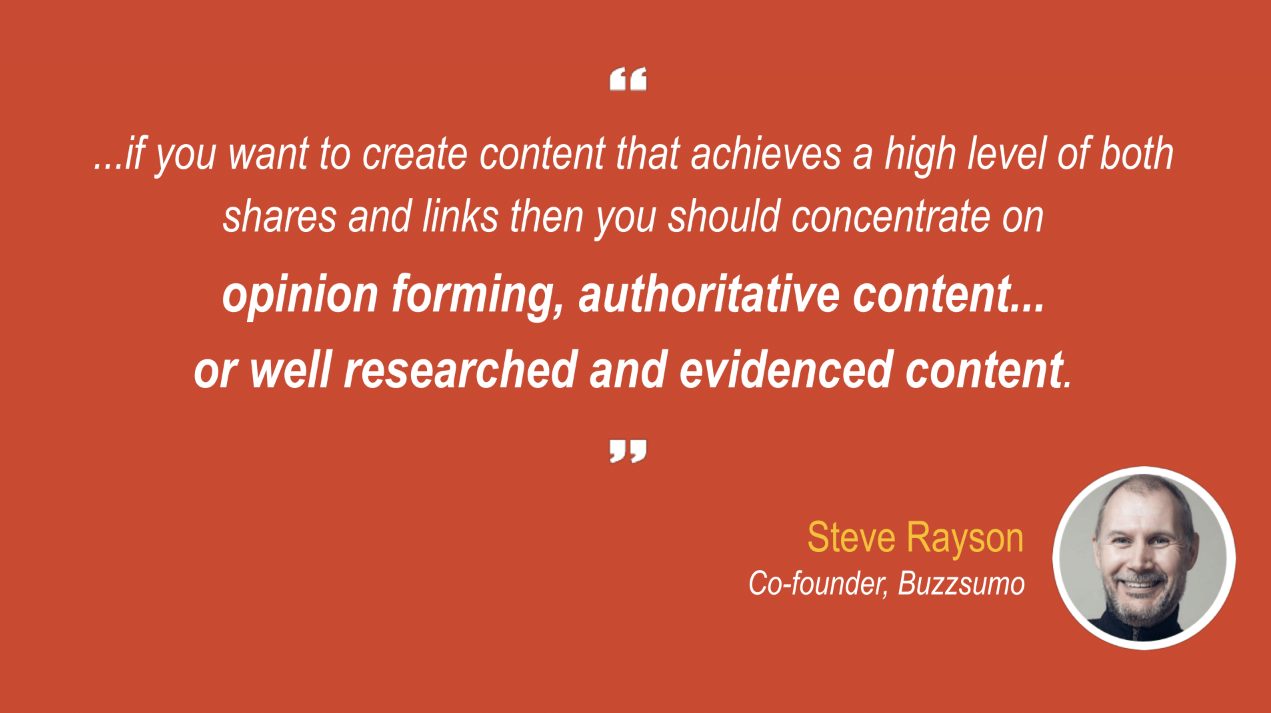
Some great ideas to get your engagement and authority increased can be the following:
- Create Original Research
- Collaborate with Influencers
- Publish Everywhere
- Guest Blog – “If you’re not making friends, you’re doing it wrong.”
- Update Older Content
- “Defend your traffic Magnets.”
- Upgrade to Visual Formats
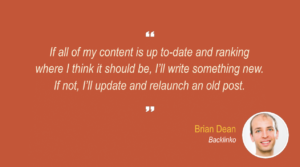
When considering where to put your time and energy in your content, consider making the best page on the internet for your topic. If you are an authority in your industry, then the information you provide should be authoritative. You don’t need 1,000 articles—you need 100 great articles.
As part of your overall content strategy you should use URLs that are easy to reuse later so you can truly have evergreen content. This includes no numbers and no formats.

Turning your top blog post into a video or infographic can help bring traffic and authority to your blog. If your content is anchored in original research, influencer powered, PR focused, and updated consistently, you will be far ahead of the competition.
Running Your Own SEO Tests: Why It Matters & How to Do It Right | Rob Ousbey
To see Rob’s slide deck, click here.
Google is changing its algorithms more and more as time goes on as they are collecting an ever increasing amount of data for users. Traditional ranking signals don’t hold the same sway they used to and because of this, Rob suggests that we conduct our own tests of what moves the needle for our businesses and websites.
"SEO is changing."
We've gone from easy-to-describe bad user experiences to hard-to-define good user experiences.
Running Your Own SEO Tests: Why It Matters & How to Do It Right@RobOusbey #MozCon #BoostatMozCon pic.twitter.com/BIz0zKiXlr
— Boostability (@Boostability) July 17, 2019
Rob states that in his tests he has begun to suspect that Google is beginning to rely on user experience rather than traditional factors like links or post design. This is due to the ease of detecting spam in the past versus what is counted as quality content today.
“Through SEO A/B testing:”
- Google relies less heavily on link signals when it comes to the top half of the results on page 1.
- Google relies more heavily on user experience for head terms (terms with high search volume), likely because they have more user data to draw from.
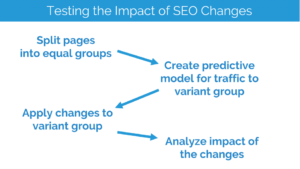
Cultivate a culture of testing, as doing so will make you a more credible marketer. Periodically challenging your beliefs as an SEO expert will help you stay on top of your game and produce results for you and your clients. You can do this by setting up an interdisciplinary team that resembles something like this:
-
- Analytics
- SEO
- Statistician
- Back End Dev
- Front End Dev
By challenging and testing even what Google says they are doing you can find the truth of what works to increase traffic and ranking. Rob conducted a test on JavaScript enabled/disabled pages and saw that, even though Google said it was able to crawl and index sites like a browser, there was an increase in traffic when content was loaded directly in HTML. Consider split testing your SEO data with DistilledODN.com and Distilled.net to get the most out of your time and efforts.
Dark Helmet’s Guide to Local Domination with Google Posts and Q&A | Greg Gifford
To see Greg’s slide deck, click here. To see his guide to Google Posts photos, click here.
Using Google My Business (GMB) is essential to any local campaign in today’s SEO landscape but using it effectively can give you more conversion than ever before.
Google Posts allows you to drive conversions without driving people to your site – convert on zero-click searches! @GregGifford #MozCon
— Ruth Burr Reedy (@ruthburr) July 17, 2019
Greg walks us through two tools (Posts and Q&A) from GMB that we can be using to better reach our local audiences. He states, “The biggest change from 2017 to 2018 is that GMB signals were increased 32.14%.” and that if you are looking to rank for zero-click searches them GMB is your new home page.
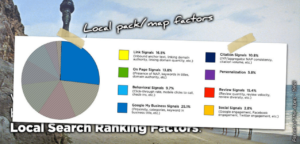
Google Posts are a great way to engage with your audience and appear with a voice in the local search realm. Making the small posts could take as little as 10 minutes, and if you post once a week, it’s only 40 mins a month for a possible increase in engagement. Once posted, it will stay live for seven days unless you use a template with a date range. But modifying that date range isn’t always a good idea, as much of the information about Google Posts is often incorrect. Greg gives us a tool that we’ve linked to at the top of this section to help get through the misinformation about posts.
GMB Questions and Answers can be asked and answered by anyone. Because of this, you should be doing both yourself.

The answer with the most upvotes appears as the primary answer in native search. Doing these two things will help you stand out above your competition.
How to Audit for Inclusive Content | Emily Triplett Lentz
To see Emily’s slide deck, click here. To see her overview of inclusive audit tools, click here.
In an ever-changing professional landscape, we can’t forget ourselves and be insensitive with our content. Emily walks us through some common miss-steps in content and how we can be more inclusive with our audiences in the future.
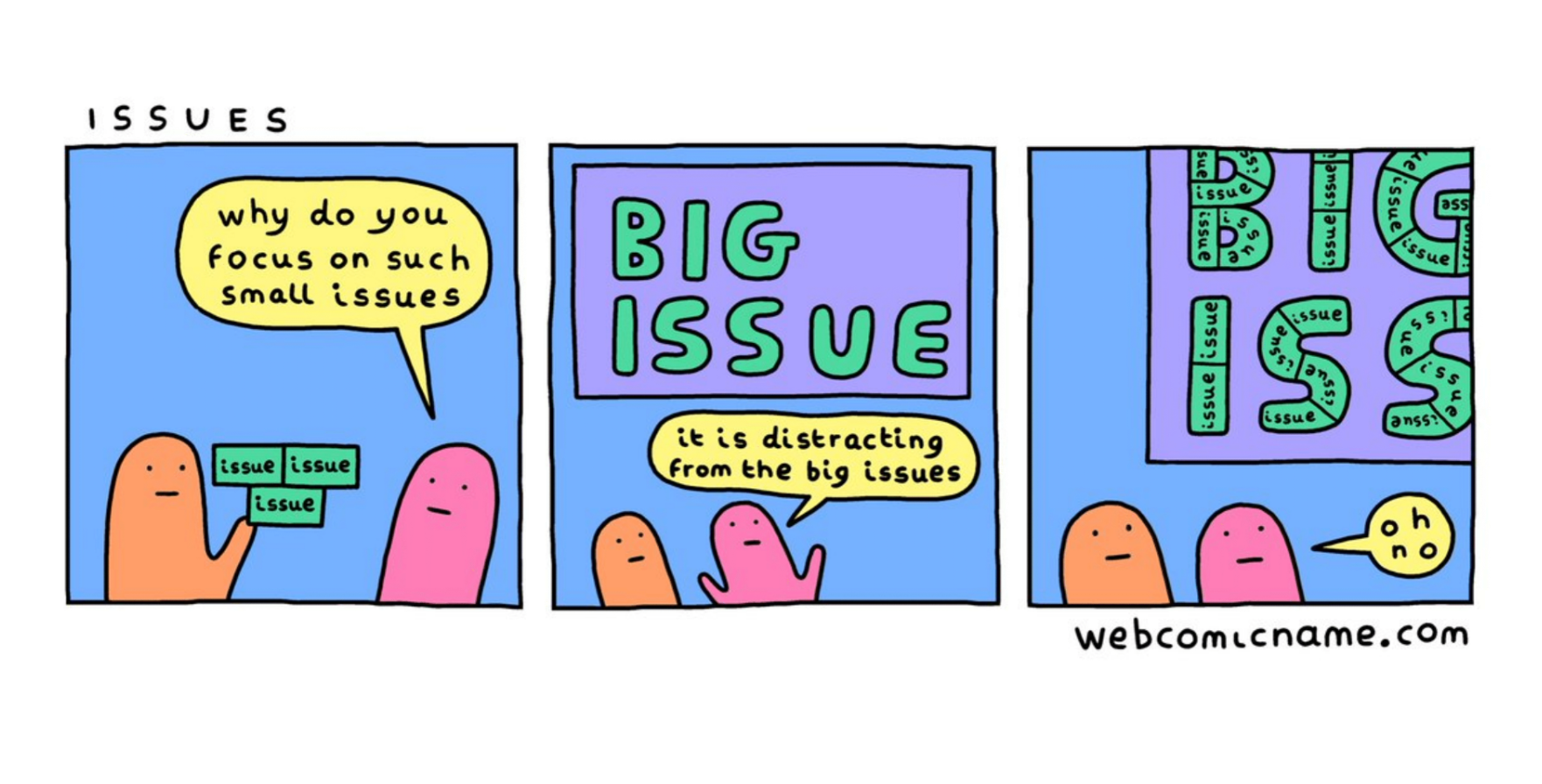
“When we can choose between behavior that upsets some people versus behavior that upsets no one… why wouldn’t we choose to upset no one?” – Emily Triplett Lentz
Being inclusive and aware of what your brand messaging/content can help reach a wider range of audiences. BE AWARE OF WHAT YOU SAY AND WHY YOU SAY IT.
How to Audit for Inclusive Content@emilytlentz #MozCon #BoostatMozCon pic.twitter.com/IL3jcngVyB
— Boostability (@Boostability) July 17, 2019
Image & Visual Search Optimization Opportunities | Joelle Irvine
To see Joelle’s slide deck, click here.
The process of using an image to search for a product is relatively new but it is here.
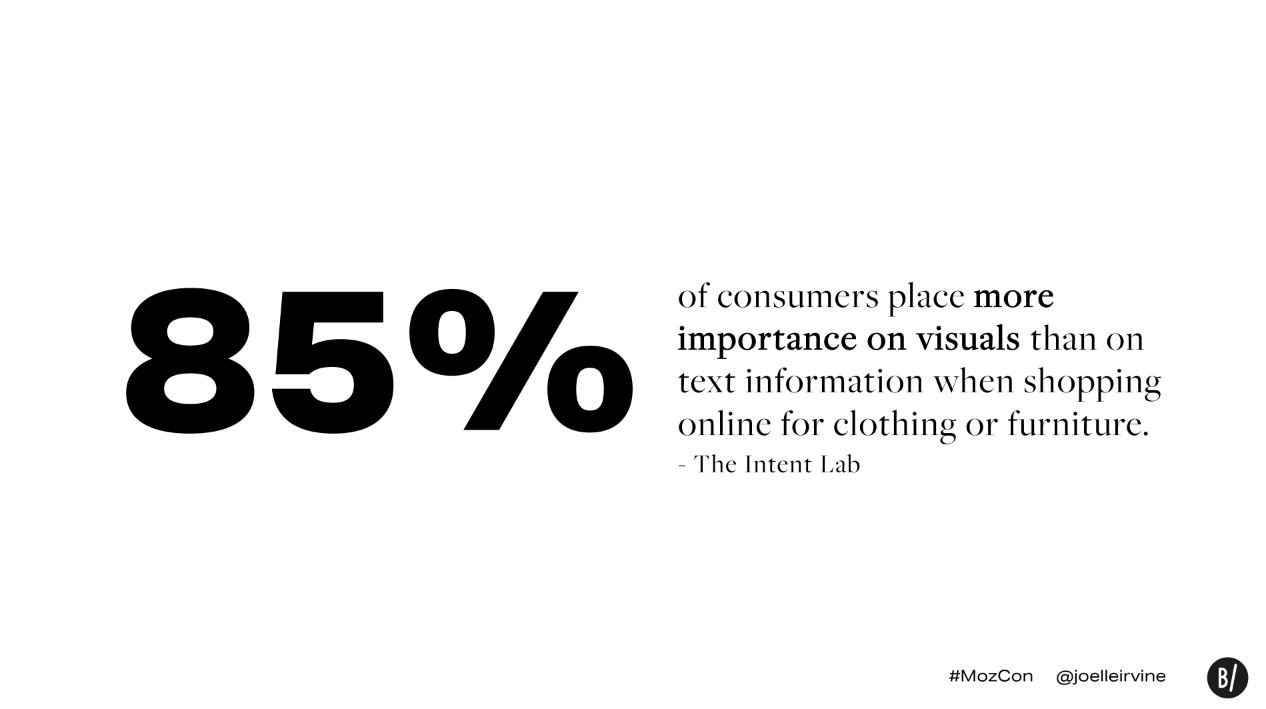
Pinterest has a great tool and a bunch of data that can help you with a hybrid search result. This can help you find products that look similar to the one you uploaded or even connections to the product that complement it.
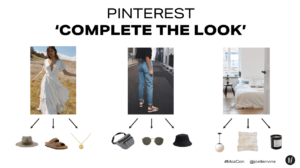
With the advent of Google AR and Pinterest Image Search, you can help new customers see your products and lesser known brands can stand out. In order to optimize for these types of searches, you really just need to optimize your photos via SEO Best-Practices. This includes things like alt tags, image size and responsiveness.
Image optimization and following proper best practices are paralleled with best practices for visual searches.
This means product data, image sitemap and size are all essential to optimize for the future of visual searches.@joelleirvine #MozCon #BoostatMozCon
— Boostability (@Boostability) July 17, 2019
Factors that Affect the Local Algorithm that Don’t Impact Organic | Joy Hawkins
To see Joy’s slide deck, click here. To see her blog post about Proximity, click here. To see her blog post about the Local 3 Packs & GMB, click here.
When thinking about local rankings, there are many factors that come into play as it has its very own algorithm. Joy Hawkins guides us through what is taking place in the local vs organic landscape of SERPs.
Here is a list of factors that come into play when local search results are explored:
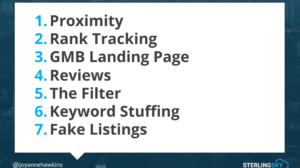
Proximity comes into play when considering where you rank in local search results. There is a multitude of data that shows you rank differently depending on where your customers are searching. There is also a difference in rankings depending on time of day past the Top 5.
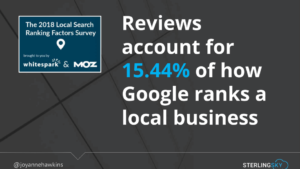
Ranking is based on a lot more than just who has the best reviews. You can use the list above to see what else your business can do to help their local rankings.
Review-gating (channeling bad reviews through private forms) is against Google’s GMB guidelines and it can cause your account to be suspended & lose all its reviews. Insane. @JoyanneHawkins #mozcon pic.twitter.com/ecEJABI18l
— Lily Ray 😏 (@lilyraynyc) July 17, 2019
Google is cracking down on fake listings more so than ever before. Many of them were reported by users and you can contribute to cleaning up the internet by contacting them directly.
Featured Snippets: Essentials to Know & How to Target | Britney Muller
To see Britney’s slide deck, click here.
To end the last day of MozCon 2019, Britney Muller gives us the much anticipated speech on Featured Snippets. She goes through what they are and how to rank for them. Their frequency of appearance has increased 165.6% since 2016. Because they are more common than ever and we will need to understand what a featured snippet is.
They can be easily categorized by these 5 examples:
- Paragraph
- List
- Table
- Video
- Accordion
These five are all seen on the SERP page and depending on the question asked you will see different one or two of these types of results.
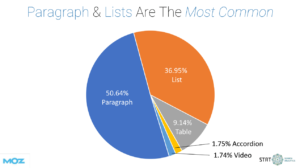
In all of these results there are 93.8% of them that also contain a People Also Ask box. This is an effort to continue a conversation with the searcher as these boxes are used to answer questions that are related to your search query. In her searches Britney found that half of all Featured Snippets are part of a carousel.
When trying to rank for Featured Snippets, you can to consider different trigger words. For example, there are different trigger rates for paragraph, list and table results. These include words like “does,” “cost,” “difference,” “best,” “improve,” “workouts,” “rates,” “fixed,” and “salary.”
Answering some of the most common questions surrounding "start word triggers" with quality content can help you rank for featured snippets.
These triggers are words like begin with "how" or "why"@BritneyMuller #MozCon #BoostatMozCon
— Boostability (@Boostability) July 17, 2019
In order to decide on whether or not you are going to pursue a snippet listing you need to ask yourself if this is going to drive traffic and if your website is setup to capitalize off this traffic.
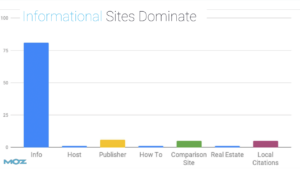
In the FS realm, the informational sites have the vast majority of results as they are providing the data needed to answer the questions. If you want to rank, your content will need to be informational. It will need to have the data ready and optimized to be supplied to Google. You can do this by using Schema.org markup and testing.
“If you aren’t breaking anything then you aren’t trying hard enough.” – Britney Muller
7 Featured Snippet(FS) actions to take from @BritneyMuller
1: Know which FS keywords you rank for
2: Know intent
3: Provide succinct answers
4: Add summaries to blog posts
5: Identify commonly asked questions
6: Leverage Google's NLP API
7: Monitor FS#MozCon #BoostatMozCon— Boostability (@Boostability) July 17, 2019
Using various tools to determine what FS you rank for and why can be extremely helpful. Considering intent and providing succinct answers can also help Google’s Machine Learning algorithm to get the answer easily. You can also use the People Also Ask boxes to help with questions and use expert interviews to get good answers in your content.
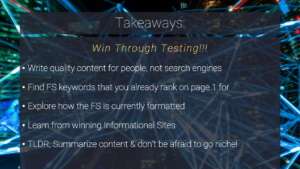
Conclusion
We here at Boostability don’t pretend to be the best—we are the best. We’re known worldwide to be the leader in white label marketing and get results for our clients. It’s encouraging to see so many speakers from different aspects of the SEO realm that reaffirm the strategies that we offer our white label partners and businesses. If you have any questions about any of the findings here, please leave a comment below!

